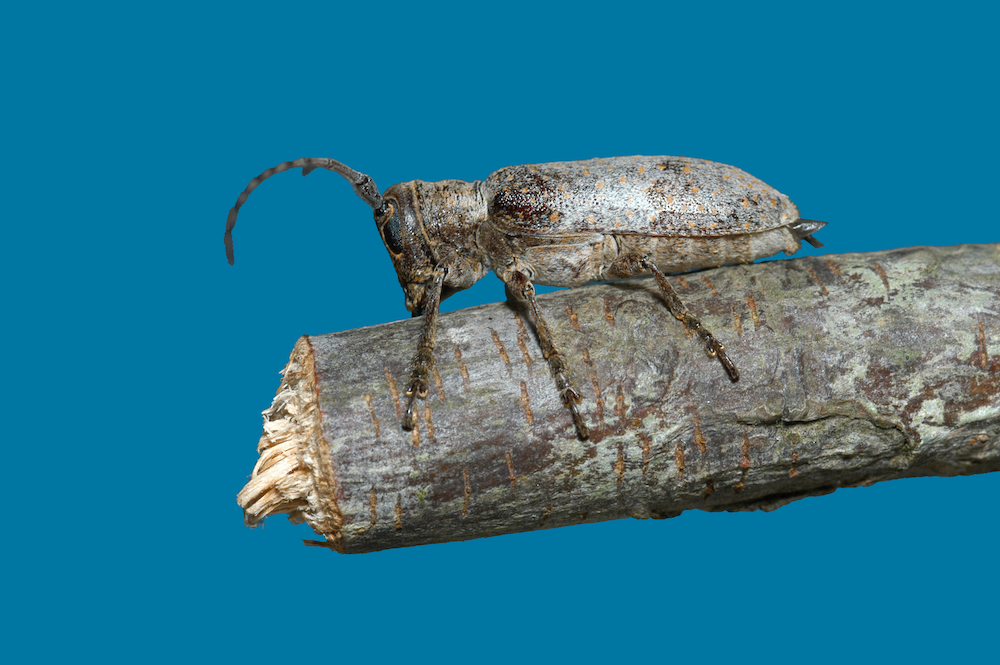Twig Girdler, Vol. 7, No. 24
Related News
October 1, 2013
September 10, 2013
June 24, 2013
June 20, 2013

James was perplexed. There were dozens of one to three feet-long, pencil-sized twigs laying on the ground under the pecan and both hickory trees in the backyard. They weren’t there when he mowed last week. The ends looked like they had been cut with a saw, straight and clean, all except a little toothpick-sized bit right in the center, where it appeared to have broken. He could look up in the tree and see the ends of some of the twigs these sticks had come from, also cut straight and clean. What could have done this? Squirrels?
Twig girdlers have mystified many gardeners, naturalists, and novice squirrel hunters over the years. The cuts are so neat and clean, and the fallen twigs are so uniform in size that the damage does not look like it was caused by any type of animal. Twig girdlers belong to a large family of beetles known as longhorned woodboring beetles because of their unusually long antennae. Most longhorned beetles lay their eggs on trunks and logs of dead or dying trees, and the resulting larvae live as wood bores within the wood. Female twig borers lay their eggs in pencil-sized twigs of living trees, but they make sure the twigs are dead by the time the eggs hatch.
After they emerge and mate in the fall, female beetles choose twigs of just the right diameter and chew a groove around the twig, leaving a small column of intact wood in the center. Then they move farther toward the end of the twig and deposit eggs. Girdled twigs die and begin to dry out, usually with the dried leaves intact, eventually falling to the ground due to their own weight or heavy wind. Eggs hatch in the fall and the larvae feed inside the twigs until late summer, when they pupate to emerge as adults around August to September. Hickory, pecan and elm are the species most favored by twig girdlers, but they also attack other hardwoods.
Another longhorned beetle, known as the twig pruner, also girdles twigs of hardwood trees. But with twig pruners it is the larvae that do the girdling, by chewing through the wood from the inside and leaving only a layer of bark intact. Then the larvae pupate in the distal end of the twig, which eventually breaks and falls to the ground with the pupa inside. With twig pruners, it is the larvae that girdle the twigs—from the inside out. With twig girdlers, it is the adults that girdle the twigs—from the outside in.
Control: Chemical control of twig girdlers is rarely justified. Low to moderate twig pruning has little adverse effect on large trees. Occasionally, young landscape trees, or young trees in pecan orchards suffer severe pruning that negatively affects future growth and aesthetics. But, as Yogi Berra might have said, by the time such damage is noticed it has already happened—meaning it is difficult to predict and proactively prevent such damage. The best cultural control is to rake and destroy fallen twigs to prevent emergence of next year’s generation of twig-girdling adults. But if there are hardwood forests nearby this may have little impact, other than to get the twigs off the lawn and out of the way of the lawn mower.
Blake Layton, Extension Entomology Specialist, Mississippi State University Extension Service.
The information given here is for educational purposes only. Always read and follow current label directions. Specific commercial products are mentioned as examples only and reference to specific products or trade names is made with the understanding that no discrimination is intended to other products that may also be suitable and appropriately labeled.
Mississippi State University is an equal opportunity institution.
Bug’s Eye View is now on Facebook. Join the Bug's Eye View Facebook group here.